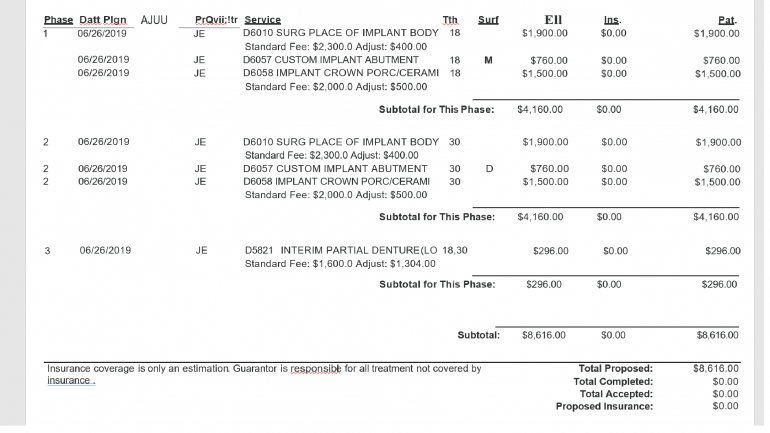
Dental Code D5110: Complete denture - maxillary
Dental Code D5110 refers to the procedure known as a complete denture for the maxillary arch, which involves the fabrication and placement of a full upper denture. This dental code is utilized when a patient requires a replacement for all of their upper teeth due to loss, decay, or other dental issues.
Dental Code D5110: Price Ranges & Savings
As with other services, prices in America vary from dentist to dentist and city to city. The minimum charge for this service is $1250 and the maximum $2500. Most dentists charge around $1700.
Low cost of living | Medium cost of living | High cost of living |
Memphis (Tennessee), Cincinnati (Ohio) | Miami (Florida), Denver (Colorado), Austin (Texas) | (New York (New York), San Francisco (California) |
$1250 | $1700 | $2500 |
Assessment and Treatment Planning
The first step in the process of obtaining a complete denture (D5110) for the maxillary arch involves a thorough assessment and treatment planning. The dentist will carefully evaluate your oral health, including the condition of your remaining teeth, gums, and bone structure. This evaluation may involve physical examinations, X-rays, impressions, and photographs.
During the assessment, your dentist will also discuss your preferences and expectations regarding the appearance and function of the denture. They will consider factors such as the color, shape, and size of the teeth, as well as the overall facial aesthetics. This information will guide the treatment planning process and ensure that the final denture meets your unique needs.
Tooth Extraction (if necessary)
In cases where any remaining natural teeth need to be extracted to prepare for the complete denture, this step will be performed. Tooth extraction is typically carried out under local anesthesia to ensure a painless procedure. The dentist will gently remove the affected teeth while taking care to preserve the surrounding gum tissue and bone.
After the extraction, it is normal to experience some swelling and discomfort. The dentist will provide you with post-operative instructions and may prescribe pain medication or recommend over-the-counter pain relievers to manage any discomfort. The extraction sites will be allowed to heal before proceeding with the denture fabrication.
Impression Taking
Accurate impressions of the oral structures are crucial for fabricating a well-fitting denture. During this step, the dentist will take impressions of the maxillary arch using dental putty or other suitable materials. The impressions capture the shape and contours of the gums, which serve as the foundation for the denture.
To obtain the impressions, the dentist will place a tray filled with the impression material over the gums. the patient will be asked to bite down gently to ensure that the impressions accurately capture the shape of the mouth. The impressions are then carefully removed and sent to a dental laboratory, where skilled technicians will use them to create a custom denture that fits the mouth precisely.
Bite Registration
To ensure proper alignment and occlusion of the denture, a bite registration is obtained. This step involves having the patient bite down on a soft material or a wax rim while the dentist records the relationship between the upper and lower jaws. The bite registration helps determine the correct position of the teeth in the denture, ensuring that it provides an optimal bite and functional chewing ability.
During this process, the dentist may ask the patient to perform various movements such as biting, chewing, and speaking to evaluate the harmony and stability of the denture. This information is crucial for achieving a denture that allows for proper speech and efficient chewing function.
Denture Try-in and Denture Delivery & Adjustment
After the initial fabrication of the denture, a try-in appointment will be scheduled. During this appointment, the patient will try on the denture to assess its fit, comfort, and aesthetics. the dentist will make any necessary adjustments to ensure a proper fit and appearance.
The try-in stage is an opportunity for the patient to provide feedback regarding the denture's appearance, comfort, and functionality. It is crucial to communicate any concerns or discomfort to the dentist during this stage, as they can make the necessary adjustments to achieve the desired outcome.
Once the denture has been finalized and approved during the try-in appointment, it will be delivered to the patient. the dentist will provide instructions on how to care for and maintain the denture to ensure its longevity and optimal performance.
It is normal to experience a brief adjustment period as the patient adapt to wearing the denture. the patient may initially experience some discomfort or difficulty speaking and chewing, but these issues can be addressed through minor adjustments. the dentist may schedule follow-up appointments to make any necessary adjustments and address any concerns that may arise during this adjustment phase.
Summary of Dental Code D5110
Dental Code D5110 represents the complete denture procedure for the maxillary arch. From the initial assessment and treatment planning to the final delivery and adjustment of the denture, each step plays a vital role in ensuring a well-fitting, functional, and aesthetically pleasing outcome.
The process involves a comprehensive evaluation of the oral health, potential tooth extractions, precise impression taking, bite registration for proper alignment, denture try-in for fit and aesthetics, and final delivery with instructions for care and maintenance. By following these steps, the dentist aims to provide the patient with a complete denture that restores the smile, improves the ability to chew and speak, and enhances the overall oral health and well-being.
Transform the smile without the hefty price tag with Dr. BestPrice! Compare costs, make strategic choices, and enjoy affordable, effective care.
